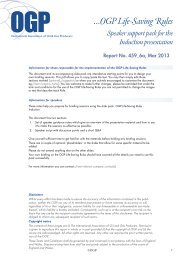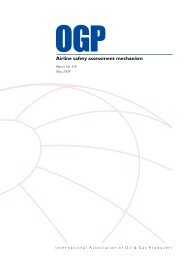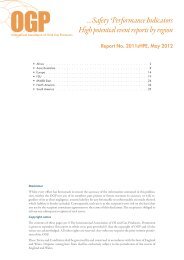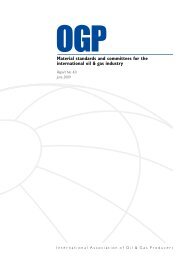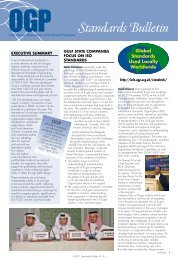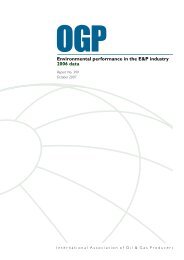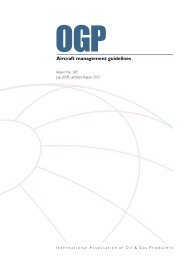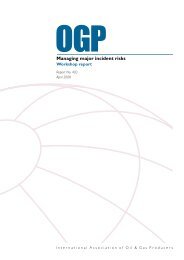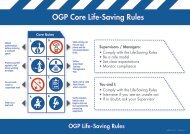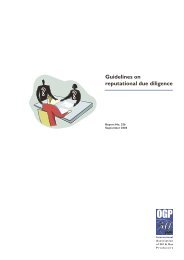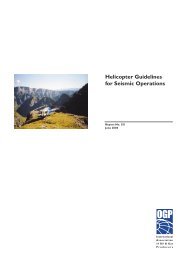Helicopter guidelines for land seismic & helirig operations - OGP
Helicopter guidelines for land seismic & helirig operations - OGP
Helicopter guidelines for land seismic & helirig operations - OGP
Create successful ePaper yourself
Turn your PDF publications into a flip-book with our unique Google optimized e-Paper software.
<strong>Helicopter</strong> <strong>guidelines</strong> <strong>for</strong> <strong>land</strong> <strong>seismic</strong> & <strong>helirig</strong> <strong>operations</strong><br />
5 <strong>Helicopter</strong> per<strong>for</strong>mance and role equipment<br />
standards<br />
5.1 General<br />
5.1.1 Seismic <strong>operations</strong> generally demand an aircraft to be operated in the low-level, lowspeed<br />
regime. Furthermore, helicopter assistance is only mobilised in terrain and<br />
conditions where cheaper ground/water transport is unable to provide the logistics<br />
needed, ie over terrain that will be classified as “Hostile” <strong>for</strong> part of the area. From<br />
this, it will be evident that high demands will be put on helicopter per<strong>for</strong>mance<br />
during <strong>seismic</strong> <strong>operations</strong>.<br />
5.1.2 Careful consideration of the aircraft type and configuration should be made during<br />
the initial planning and tendering phase of the <strong>seismic</strong> operation with appropriate<br />
input from qualified aviation expertise.<br />
5.1.3 In determining the type of aircraft, its configuration and the operational parameters<br />
to be specified <strong>for</strong> a specific project, the user should first determine the type of<br />
operating environment using the following definitions of Hostile and Non-Hostile<br />
Environment:<br />
1. Hostile Environment: An environment in which a successful emergency<br />
<strong>land</strong>ing cannot be assured, or the occupants of the aircraft can not be adequately<br />
protected from the elements, or search and rescue response/capability cannot be<br />
provided consistent with the anticipated exposure.<br />
2. Non-Hostile Environment: An environment in which a successful emergency<br />
<strong>land</strong>ing can be reasonably assured, and the occupants of the aircraft can be<br />
adequately protected from the elements, and search and rescue response/<br />
capability can be provided consistent with the anticipated exposure.<br />
5.1.4 The most significant choice to be made is between Single and Twin engine aircraft.<br />
The general guidance on this is given below, but a final decision should be based on<br />
the risk assessment described in Annex A.<br />
1. A twin engine aircraft able to sustain one engine inoperative (OEI) flight,<br />
after jettisoning any external load, is recommended <strong>for</strong> <strong>seismic</strong> <strong>operations</strong> in a<br />
predominantly Hostile Environment.<br />
2. Single engine aircraft that have been approved by a qualified aviation advisor<br />
may be used in a Non-Hostile Environment, subject to further risk assessment.<br />
3. Where flying over built up or congested areas can not be avoided, twin engined<br />
aircraft should be considered, capable of meeting the requirement stated in<br />
point 5.2.1 below.<br />
5.1.5 Aircraft to be approved and registered with CAA.<br />
5.1.6 For passenger transport, Per<strong>for</strong>mance Class 1 helicopters should be given preference.<br />
When not available, Per<strong>for</strong>mance Class 2 should be the next selected and if neither<br />
available Per<strong>for</strong>mance class 3 helicopters can be used subject to risk analysis. Ref.<br />
AMG Section 5.1.4 and 5.2 <strong>for</strong> additional guidance.<br />
5.1.7 External load <strong>operations</strong> should only be conducted with a helicopter <strong>for</strong> which an<br />
approved Supplement to the aircraft Flight Manual <strong>for</strong> external load <strong>operations</strong> exists<br />
and which is in compliance with this Supplement.<br />
5.1.8 <strong>Helicopter</strong>s should have engine trend analysis recorded and reviewed on a daily basis<br />
by technical staff.<br />
5.1.9 See section 9.2 <strong>for</strong> detailed per<strong>for</strong>mance planning requirements.<br />
© <strong>OGP</strong><br />
13



